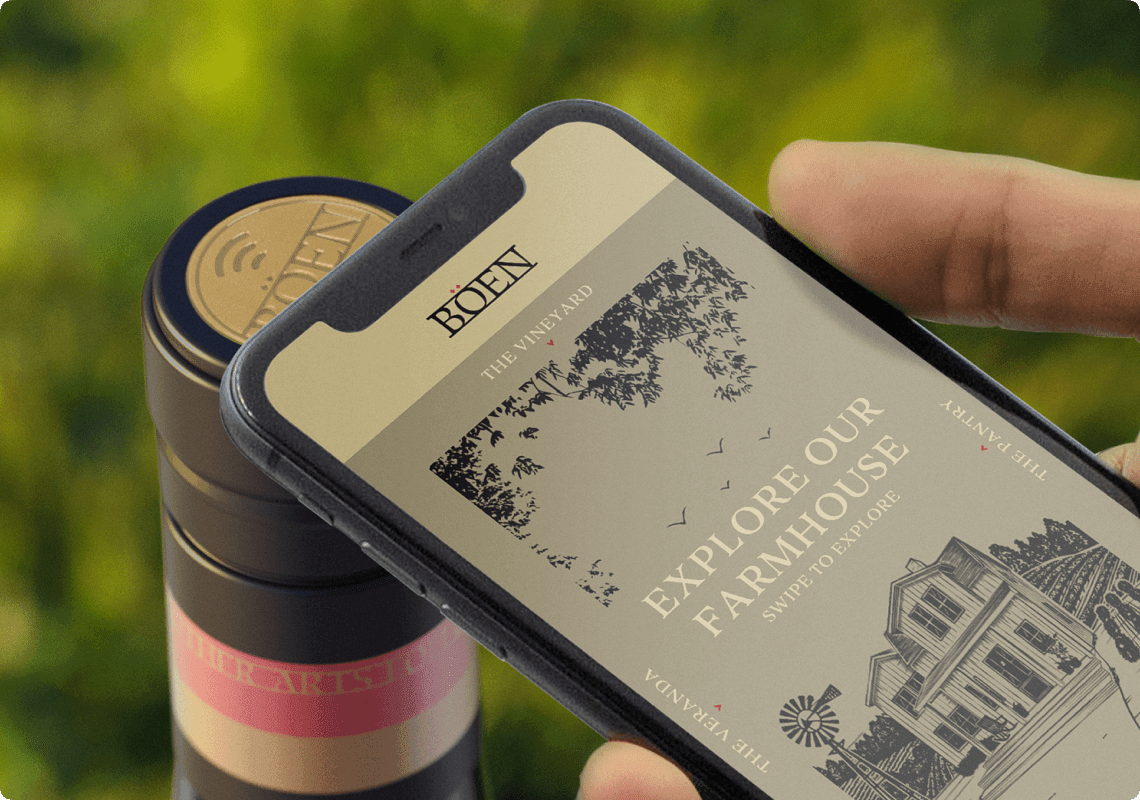




The Future of NFC
As the digital and physical worlds increasingly intersect, Near Field Communication (NFC) is emerging as a game-changer in creating connected experiences. NFC’s unique ability to exchange data over short distances with minimal energy consumption is already reshaping interactions across retail, fashion, wine & spirits, and consumer goods industries.
Let’s explore the evolving role of NFC, its unique applications across various sectors, and how brands can leverage this technology to deepen consumer connections and enhance engagement.
What is NFC and how does it work?
NFC is a wireless technology that enables two devices to communicate when in close proximity, typically within a few centimetres. Unlike Bluetooth or Wi-Fi, NFC operates without the need for complex setups or device pairing. This simplicity makes it ideal for embedding in physical products, packaging, or labels, allowing consumers to tap their smartphones to access content or verify authenticity.
Connected packaging and labels: A new touchpoint for brands
NFC-powered connected packaging transforms packaging or labels from static information sources into dynamic digital touchpoints. This innovation enables brands to engage consumers even after purchase, gathering insights on usage, preferences, and interactions. Connected packaging offers brands a streamlined way to collect valuable first-party data, which has become increasingly critical as traditional data sources, like cookies, lose effectiveness.
Beyond consumer engagement, NFC-enabled packaging supports product traceability and authentication. This is particularly significant in industries such as fashion, beauty, and pharmaceuticals, where customers demand assurance regarding product safety and quality. With an NFC tag, consumers can confirm authenticity, access tailored usage instructions, and receive personalised recommendations.
Using NFC to enhance consumer engagement and collect first-party data
NFC’s practicality makes it a promising tool for enhancing consumer engagement. Brands are leveraging NFC to create seamless, data-rich experiences through product packaging or in-store displays. For instance, NFC-enabled products allow consumers to access detailed information, view personalised content, and participate in promotions with a simple tap.
As products become more connected and consumers show greater willingness to engage, brands are discovering new ways to collect customer data. According to our Connected Experience Report, 92% of brands consider first-party data crucial to their marketing strategies, and NFC helps capture this data through direct consumer interactions.
Key use cases of NFC
Wine & spirits: Exclusivity and brand storytelling
NFC is transforming the wine and spirits industry by engaging consumers with a brand’s heritage and exclusivity. By tapping an NFC-enabled bottle, customers can access information about the product’s origins, tasting notes, and even food-pairing recommendations.
Fashion and beauty: Enhanced brand loyalty and authenticity
In the fashion industry, NFC bridges the physical and digital worlds, addressing authenticity concerns. Luxury brands embed NFC tags in high-end garments or accessories, allowing customers to authenticate purchases, learn about sustainable sourcing, or access exclusive content. For instance, Balmain’s NFC-enabled collaboration with Pokémon lets users tap an NFC patch to unlock exclusive rewards and content, fostering engagement and a sense of exclusivity.
Consumer goods: Transparency and sustainable practices
NFC is gaining traction in consumer goods, where transparency and sustainability are top priorities. Brands use NFC to provide detailed information about a product’s origins, sustainability practices, and recycling instructions. With consumers becoming more eco-conscious, NFC-enabled packaging demonstrates a brand’s commitment to sustainability, as highlighted in our Connected Experience Report, where 85% of brands stated that connected experiences support sustainability goals.
Key drivers for NFC adoption: Data, compliance, and consumer engagement
The rise of NFC is driven by the need for first-party data, compliance with evolving regulations, and the pursuit of deeper consumer engagement. Regulations like Digital Product Passports and sustainability directives require brands to provide transparency about product origins, ingredients, and environmental impact. NFC technology enables compliance by offering consumers instant access to this information.
Additionally, today’s consumers expect personalised, engaging experiences and seamless access to information. NFC meets these expectations, helping brands deliver personalised content and gather data for future interactions. As data-driven strategies gain momentum, NFC provides an effective way to gain insights directly from consumer interactions.
The way forward for NFC in a connected world
As brands recognise NFC’s potential to enhance consumer experiences and build loyalty, adoption of this technology is set to grow. According to our Connected Experience Report, 85% of brands plan to invest in NFC within the next 12 months, signalling a bright future for NFC in connected packaging and consumer engagement.
From retail to fashion to wine & spirits, NFC empowers brands to create interactive, transparent, and data-rich consumer journeys. For businesses aiming to stay competitive, adopting NFC is more than just a technological upgrade — it’s a strategic move aligned with digital-first consumer expectations and regulatory trends. As brands continue to innovate, NFC will play a pivotal role in building trust, forging meaningful connections, and enabling a sustainable, transparent future.
Talk to our team today to find out how io.tt can help your brand leverage NFC in your packaging - or start a free trial to find out yourself.
